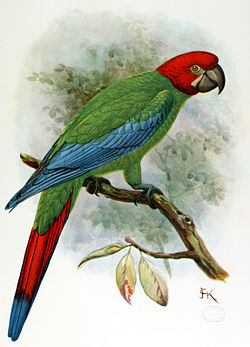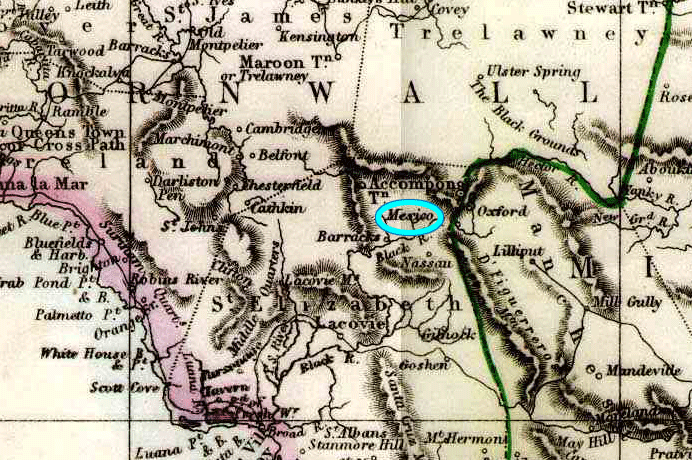 Ara erythrocephala (Hypothetical) Plate 12 from Rothschild (1907) Image is in the public domain. |
 Military Macaw Ara militaris |
| Described by: | Rothschild 1905. | |
| Authority: | Richard Hill, conveyed by Phillip Henry Gosse (1847) | |
| Type Locality: | No museum specimens exist | |
| Distribution: | Jamaica...and Mexico if it was, in fact, Ara m. militaris | |
| Range of occupancy: | "Central mountains westward of the island... ...in the neighbourhood of the Accompong Maroons..." (Gosse 1847) i.e. Cockpit Country |
|
| Status: | Extirpated | |
| Cause(s) of Extirpation: | Most likely hunting and collecting for trade | |
In what is the most-comprehensive review of West Indian macaws, Wiley and Kirwan (2013) conservatively excluded Ara erythrocephala from the "List of Endemic West Indian Macaws" owing to the fact that:
I definitely agree with Jim Wiley and Guy Kirwan about the confusing descriptions of macaws in Jamaica: I wish I had avoided sticking my nose into the murky miasma of macaws!
But two aspects of the account conveyed by Gosse (1847) and that of another reliable observer, William T. March (1863), make me not quite ready to write-off this macaw from a list of Jamaica's extinct avian heritage.
The things which catch my attention are:
 Which Oxford Estate: Trelawny Parish or St. Elizabeth/Manchester?
Which Oxford Estate: Trelawny Parish or St. Elizabeth/Manchester?
Gosse / Hill unfortunately did not note the parish when reporting on the acquisition of the macaw by "Mr. White,
the proprietor of Oxford estate". From a letter to Gosse posted by William Osburn in 1859 from Freeman's Hall, Trelawny, Wiley and
Kirwan (2013) not unreasonably concluded the reference was to the
Oxford Estate located in Trelawny parish and they included the latitude & longitude coordinates: ca.18°27′00" N, 77°34′58" W; 200 m elevation.
Subsequent to this publication, WRC Director Catherine Levy discovered in almanacs from the late 1820s that a Mr. Andrew White was the proprietor of the Oxford Estate which straddles the southern parishes of St. Elizabeth and Manchester. Mr. White's death was recorded in the 1840 St. Elizabeth almanac. She and I believe it is more likely that this southern Oxford Estate (centered at: 18°11′00" N, 77°37′45" W), is the "Oxford" to which Hill and Gosse were referring.
Cockpit Country: the macaws' last sanctuary?
Regardless of which Oxford Estate is correct, when the historic accounts included a location name of macaws either being seen, harvested or shot, all locations were in Cockpit Country, a karst landscape whose ruggedness has afforded protection from deforestation. The current forest cover is, in essence,
a 'residual area' of the closed broad-leaf forest which once blanketed the central limestone plateau of Jamaica. The absence of surface water in Cockpit Country even today
limits the distribution of permanent human settlements. And where humans aren't permanently settled...forest-dependent wildlife
can find sanctuary.
A note by Hans Sloane (1725, pg 297) - "The Small Maccaw...are very common in the Woods, and are eaten as Pigeons; but when young are tamed; and kept as Parrots" suggests that, in accessible areas, macaws (which are generally quite conspicuous by their vocalisations and visible when flying above a forest canopy) were relatively easy to hunt. John Taylor also recorded in 1687 that "...on this isand a marcough...held as a great rarity, there being but a few of them...hard to come at, because they are noewhere to be found but in the woody maintaines."
And this brings us back to the ruggedness of Cockpit Country and the fact that until the British signed a Peace Treaty with the Leeward Maroons (of present-day Maroon Town and Accompong) in 1738 / 39, exploitation of the area's natural resources and incursions deviating from the major military trails & bridle-path network would have been limited. After the Peace Treaty, the "mountains" in Cockpit Country became available for the colonial estates to extract timber and wood-fuel for lime production and for slaves to grow ground provisions (e.g. yam). The Treaty opened-up Cockpit Country for incursions by humans, to collect resources to carry-back to their permanent settlements. If macaws had been present in the interior forest, encounters with humans would have increased, and sanctuary decreased.
Large birds such as macaws, captured with "bird lime" (e.g., the latex of the introduced Breadfruit (Artocarpus altilis) tree smeared on a branch) or killed by a catapult (slingshot), would certainly have been a good protein source for Maroons and other communities in-and-around Cockpit Country; they also would have been a valuable commodity to sell because of their rarity. From Hill's account (in Gosse 1847, pg 263) the Accompong Maroons knew how to harvest young birds -- just as some Jamaicans today know how to illegally poach Amazona nestlings. Further, having been granted the privilege of "...the liberty to hunt where they shall think fit ... " (Peace Treaty, Fifth Section, 1738-39), the Maroons likely were proficient hunters, particularly in comparison to other slaves prior to Emancipation in 1836. And the Maroons knew Cockpit Country better than anyone.
Thus, when I read the historical descriptions of macaws, look at the spatial distribution of sightings in the context of Jamaica's colonial period (and associated land use patterns and settlements), and consider the wildlife exploitation opportunities which were created by the signing of the Maroon Peace Treaty, I can easily envisage species decline in the 18th century and the extirpation of forest-dwelling macaws within the time frame of Richard Hill, P. Henry Gosse and William March.
It is also the remoteness of the locations which leads me to believe that this Military Macaw-like species was native, not a feral population of human-habituated birds which escaped from the caged-bird trade.
Gosse (1847, pg 270) also added one other intriguing comment from a Dr. Anthony Robinson: "Robinson, in enumerating the Jamaican Psittacidae, distinguishing them from introduced specimens, mentions in addition to those I have given, "the Mountain Parroquet." . Gosse had already described the "Yellow-bellied Parroquet" (i.e. Jamaican Parakeet [Eupsittula nana]) in his text. Was the "Mountain Parroquet" the same "small green long-tailed Parrot" described by Patrick Browne (1756, pg 472)? And were they both describing not a parakeet or a parrot, but instead what we recognise taxonomically as a macaw?
Narrative Descriptions:
(Gosse 1847; pp. 261-63)
A letter just received from Mr. Hill, who kindly assisted my inquiries on the subject, says; - “I have ascertained with unquestionable certainty, that Macaws are
occasionally, if not constantly denizens of our mountain forests.
They are found exclusively in the central mountains westward of the island, and are observed on the skirt of the partially cleared country,
at an elevation of 2500 or 3000 feet above the sea. They have been surprised in small companies feeding on the full-eared maize, while the grain was
soft, milky, and sweet, and the very husk was sugary. Every description I have received of them, makes the species to be the Ara militaris , the Great Green
Macaw of Mexico. The head is spoken of as red; the neck, shoulders, and underparts of a light and lively green;
the greater wing coverts and quills, blue; and the tail scarlet and blue on the upper surface with the under plumage both of the wings and tail, a mass of intense orange and yellow.
 |
| Edward Weller's map of Jamaica, 1859. Intriguingly, there is an estate called "Mexico" (circled in blue) south of the Black Grounds and Accompong referenced by Hill. Gosse was based in Bluefields, so like Mr. Hill, he would have recognized the name of this estate. One wonders if this estate name subconsciously influenced Hill's conclusion that the wild macaws looked like Military Macaws from continental Mexico. |
A mountain district very remote, between Trelawney and St. Ann’s, here and there cleared and settled, - a peculiar country called the Black grounds, [NB, named for the friable, dark soils of the Central Inlier] is, said to be the never failing resort of these Mexican Macaws. I have been assured that several birds have been procured there. This is said to be nearly as far eastward as they have been found. Further westward, in the neighbourhood of the Accompong Maroons, young birds, bearing the evidence of being in the first year’s plumage, have been procured from hog-hunters. One specimen, purchased from them by Mr. White, the proprietor of Oxford estate, was for some time the admiration and talk of the country round. I have been informed by those who have noticed the bird on the wing, that although the Macaws are never seen but flying extremely high, their great size, and their splendid length of tail, brilliant with intense scarlet, and blue and yellow, strikingly attract attention, if their harsh scream, heard in the hushed mountain solitudes, does not betray them. They fly from one ridge to another, journeying in pairs, and have been followed by the eye till they have alighted on the loftiest of the forest trees, in their chosen resting places . . .
(March 1863; p. 283)
I have had no opportunity of seeing a perfect specimen of any of the Macaws said to have been found on the Island. On one of my professional visits to Montego Bay, in 1834, I saw
in the possession of a settler from the Mountains of St. James, near Accompong, the head, wings, and tail of a Macaw, which he said he shot near Maroon Town. I did not at the time take
sufficient interest in this branch of Natural History to note the particulars, but I have a perfect recollection the the head and neck were a bright green with red
in the forehead and chin, the tail blue and red, and the wing blue and green..."
Based on the locations and comments from several credible sources that macaws were found in the remote mountains,
|
References
Browne, P. 1756. The Civil and Natural History of Jamaica. Osborne and Shipton, Gray's Inn, London, UK.
Gosse, P.H. 1847. The Birds of Jamaica. John Van Voorst, London, UK.
Jamaica Almanac. 1827. Return of Givings-in for the March Quarter, 1826, County of Cornwall, Parish of St. Elizabeth.
March, W. T. 1863. Notes on the birds of Jamaica. II. Proc. Acad. Nat. Sci. Philadelphia 15: 283–304.
Rothschild, W. 1905. [Extinct parrots of the West Indies.] Bull. Brit. Ornithol. Club 16:13-14.
Rothschild, W. 1907. Extinct Birds: An attempt to unite in one volume a short account of those birds which have become extinct in historical times--that is, within the last six or seven hundred years. To which are added a few which still exist, but are on the verge of extinction. Hutchinson, London, UK.
Sloane, H. 1725. A voyage to the islands Madera, Barbadoes, Nieves, St. Christophers, and Jamaica; with the natural history of the herbs and trees, four-footed beasts, fishes, birds, insects, reptiles, &c. of the last of those islands, vol. 2. London.
Taylor, J. 2008. Jamaica in 1687: the Taylor manuscript at the National Library of Jamaica. Univ. of West Indies Press, Mona.
Wiley, J.W. and G.M. Kirwan. 2013. The extinct macaws of the West Indies, with special reference to Cuban Macaw Ara tricolor. British Ornithologists' Club 133: 125-156.

